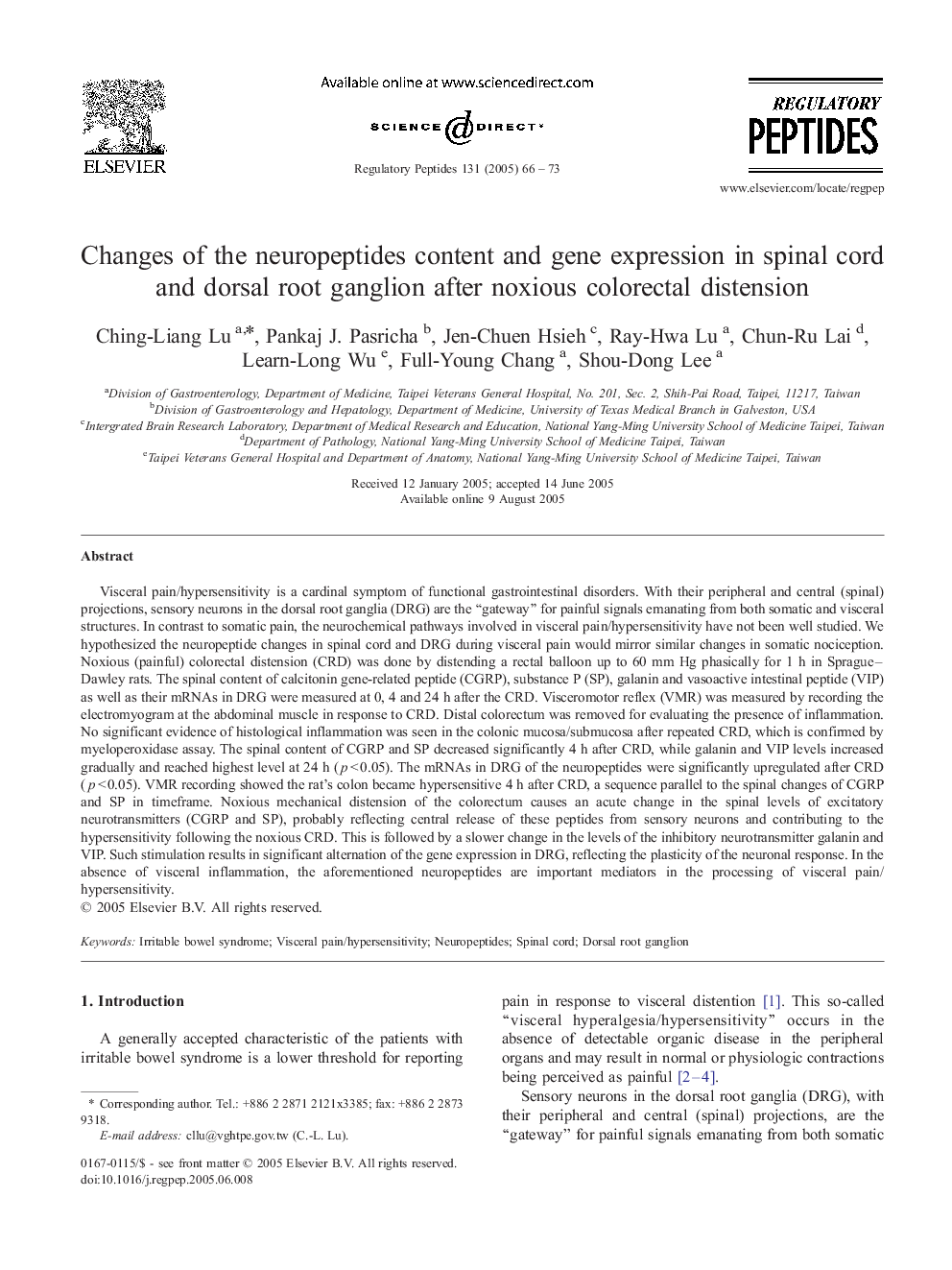| کد مقاله | کد نشریه | سال انتشار | مقاله انگلیسی | نسخه تمام متن |
|---|---|---|---|---|
| 9894371 | 1542455 | 2005 | 8 صفحه PDF | دانلود رایگان |
عنوان انگلیسی مقاله ISI
Changes of the neuropeptides content and gene expression in spinal cord and dorsal root ganglion after noxious colorectal distension
دانلود مقاله + سفارش ترجمه
دانلود مقاله ISI انگلیسی
رایگان برای ایرانیان
کلمات کلیدی
موضوعات مرتبط
علوم زیستی و بیوفناوری
بیوشیمی، ژنتیک و زیست شناسی مولکولی
زیست شیمی
پیش نمایش صفحه اول مقاله

چکیده انگلیسی
Visceral pain/hypersensitivity is a cardinal symptom of functional gastrointestinal disorders. With their peripheral and central (spinal) projections, sensory neurons in the dorsal root ganglia (DRG) are the “gateway” for painful signals emanating from both somatic and visceral structures. In contrast to somatic pain, the neurochemical pathways involved in visceral pain/hypersensitivity have not been well studied. We hypothesized the neuropeptide changes in spinal cord and DRG during visceral pain would mirror similar changes in somatic nociception. Noxious (painful) colorectal distension (CRD) was done by distending a rectal balloon up to 60 mm Hg phasically for 1 h in Sprague-Dawley rats. The spinal content of calcitonin gene-related peptide (CGRP), substance P (SP), galanin and vasoactive intestinal peptide (VIP) as well as their mRNAs in DRG were measured at 0, 4 and 24 h after the CRD. Visceromotor reflex (VMR) was measured by recording the electromyogram at the abdominal muscle in response to CRD. Distal colorectum was removed for evaluating the presence of inflammation. No significant evidence of histological inflammation was seen in the colonic mucosa/submucosa after repeated CRD, which is confirmed by myeloperoxidase assay. The spinal content of CGRP and SP decreased significantly 4 h after CRD, while galanin and VIP levels increased gradually and reached highest level at 24 h (p < 0.05). The mRNAs in DRG of the neuropeptides were significantly upregulated after CRD (p < 0.05). VMR recording showed the rat's colon became hypersensitive 4 h after CRD, a sequence parallel to the spinal changes of CGRP and SP in timeframe. Noxious mechanical distension of the colorectum causes an acute change in the spinal levels of excitatory neurotransmitters (CGRP and SP), probably reflecting central release of these peptides from sensory neurons and contributing to the hypersensitivity following the noxious CRD. This is followed by a slower change in the levels of the inhibitory neurotransmitter galanin and VIP. Such stimulation results in significant alternation of the gene expression in DRG, reflecting the plasticity of the neuronal response. In the absence of visceral inflammation, the aforementioned neuropeptides are important mediators in the processing of visceral pain/hypersensitivity.
ناشر
Database: Elsevier - ScienceDirect (ساینس دایرکت)
Journal: Regulatory Peptides - Volume 131, Issues 1â3, 15 November 2005, Pages 66-73
Journal: Regulatory Peptides - Volume 131, Issues 1â3, 15 November 2005, Pages 66-73
نویسندگان
Ching-Liang Lu, Pankaj J. Pasricha, Jen-Chuen Hsieh, Ray-Hwa Lu, Chun-Ru Lai, Learn-Long Wu, Full-Young Chang, Shou-Dong Lee,